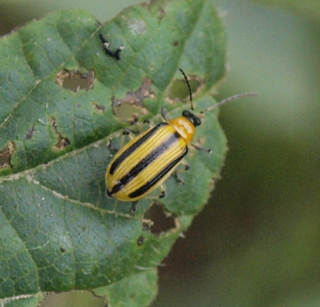Growers are ramping up to plant pumpkin, squash, melon and cucumbers through May and into June. Here are some key pests to keep in mind with seedlings and small plants this time of year.
Striped cucumber beetle – This small black and yellow striped beetle is a major pest of all cucurbits early season. In addition to the heavy feeding damage that can be inflicted upon seedlings, this feeding injury can also transmit bacterial wilt to the plant which will stunt or kill the plant. Growers can control this pest in several ways such as buying FarMore FI400 treated seed, which contains several fungicides paired with thiamethoxam insecticide that provides seedling protection for 2-3 weeks after emergence. Using an in-furrow treatment of a systemic insecticide at planting will provide a longer window of control, between 4-6 weeks. Another management option is to scout for beetles on emerged seedlings, and based on seedling stage, use a foliar spray when the threshold is exceeded according to the guide below:
0.5 beetles per plant for cotyledon through 1st leaf
1 beetle per plant for 2nd and 3rd leaf
2 beetles per plant for anything after the 4th leaf stage
Regardless of method of treatment, be sure to scout for these beetles and their damage on the underside of the cotyledons and early leaves every few days as severe damage can occur rapidly in a short period of time. Pollinators can also be affected by systemic insecticides present in pollen and nectar, so seed treatments to some degree and in-furrow products should be considered before use. Foliar applications of insecticides should be made in the evening to minimize pollinator impact.
Squash Vine Borer – The damaging stage of this pest is actually a caterpillar from moth that mimics a wasp which becomes active in early June. The best management practice for this pest is to put up a pheromone trap next to the field and monitor the number of moths caught. A week after adult moths are caught in the trap, usually around mid to late June, apply an insecticide targeted at the base of the plants where the eggs are laid 7-10 days apart for up to four weeks. If the caterpillar bores into the stem of the plant, treatment will not be effective. Systemic products such as imidacloprid, used either as a seed treatment or in-furrow application at planting, will not control this pest.
Squash Bugs – These true bugs overwinter as adults in nearby fields and can attack seedling and smaller plants with sucking mouth parts that can collapse leaves and stems. These pests can also vector yellow vine decline, a bacterial pathogen that can cause stunting and death in seedling plants. Plants infected with YVD will turn yellow about a month after being infected, and there is no remedy. YVD can look very similar to injury caused by tunneling squash vine borer larvae, so if a plant is suspected of YVD, check the base for evidence of SVB larva, usually spotted by frass surrounding entry hole. If more than one egg mass per plant is found, treatment is warranted once the nymphs hatch. If nymphs mature to adults, they are harder to control.
A list of recommended insecticides for all these pests can be found in the 2017 Midwest Vegetable Production Guide (https://btny.purdue.edu/Pubs/ID/ID-56/).





